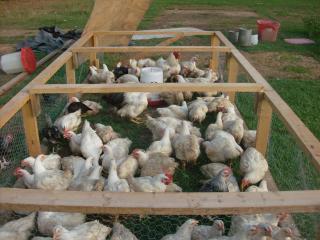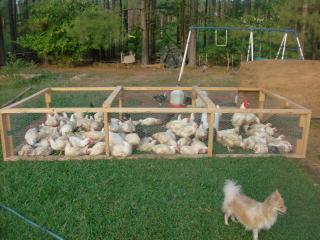Quote:
Quote:
There are literally hundreds, if not thousands of threads on this forum about how to raise meat birds, especially Cornish X's. You can do a BYC search for raising meat birds, but really, all you have to do is scroll down through a few pages of threads, click on the threads dealing with the subject, you'll find all kinds of info.
I don't know of a good over-all tutorial, but many hatcheries provide a pretty good set of instructions for care and feeding. Some of them may have this on their websites. There are so many different ways people successfully raise these birds, there's no single right answer to anything. I haven't seen charts for raising CX vs. DP, maybe somebody else knows of one.
Here's a few basic differences between dual-purpose breeds and the Cornish X's (other meat hybrids such as Freedom Rangers, etc., can usually be raised almost like a dual-purp, from what I've read, aside from still eating more than DP's. I've personally raised only dual purpose, Cornish X and some undersized meat birds I got from a broiler operation through a friend):
Meat hybrids will eat more during any given time period, than dual purpose.
Total feed consumption over time, from chick to table, will be about the same, some say the duals will eat more in the long run, that may be true. I have not done any controlled testing to see. CX's tend to die young, if you don't get them butchered and in the freezer, odds are they'll die before too long, so you want to get them in the freezer on time. The advantage with DP's over this, is that if you don't get them butchered young, yes, they are still eating your feed, but they aren't likely to drop dead on you. If you're delayed in butchering, you may end up with a bunch of slow roasters, or at worst, stewing fowl, but they're at least still food, and not just a total waste like they are if you open the coop and find stiff corpses on the floor.
Cornish X will poop a LOT more, (runny, watery, smelly poop) so you need to either move them often, hence the popularity of the movable tractors, or clean up after them often, a very disagreeable chore. Bigredfeather is raising some on an alternative feed system he's testing, it's soy free, supplemented with raw goat's milk and kefir. Last I read, they were thriving and pooping like normal chickens. So that problem might be from what we usually feed them.
Cornish X do better if you use some sort of feed restriction, such as feed for 12 hours, remove feed for twelve hours. I just stopped leaving lights on at night, as soon as they were big enough to not need the heat. A few might still find the feed in the dark and eat, but mostly, once it's dark, they'll sleep like the other chickens. You don't have to do this with dual purps.
Feeders need to be raised, to force the little pig-birds to stand up while they eat, otherwise, they will lay down to eat. Laying down to eat is bad for them, leads to weaker legs and heart attacks. Also not a problem with DP's.
Putting a little distance between feed and water is good, to force them to get up and walk a little. DP's will run around anyway, you don't have to make them move.
Cornish X's are prone to leg problems and CHF, (congestive heart failure) and heart attacks. If properly managed, these problems can be avoided. DP's rarely, if ever, get these problems, even if you aren't the best, most attentive chicken manager.
DP's grow a lot slower, and by the time they're old enough to butcher, 16-25 weeks, depending on the breed, it's not unusual for them to be crowing and chasing the hens.
If you have the space and can free-range Cornish X's, they do better than if they are confined, as far as being active and staying cleaner, and so on. They won't be as active as the dual purps. Confined birds get fatter faster, but are more inclined to drop dead. Those who are really good at raising them in confinement seem to do ok with them, though if they raise huge numbers, there's going to be a percentage of loss due to the problems I've already mentioned, and some less aggressive feeders may get pushed away from the feed, and not grow as expected.
meat quality: Cornish X make lots of tender meat, fast. They are good, but less flavorful than DP's.
DP's, if butchered between 12-16 weeks, aged properly in the fridge, they can still be tender enough to fry or grill, though they won't be very large. Older, meatier birds, will need to be cooked differently, slow roasted, crock pot, pressure cooker, or some such, in order to be tender. There are many threads on cooking dual purpose or heritage breed birds. Some of my dual purpose crosses have dressed out to over 7 lbs. (20-25 weeks old at slaughter) but others have been just over 3 lbs.
Any bird you raise yourself will be more satisfying than what you get from the store, and you know what it was fed, and how it was processed. Each kind has pros and cons, and only you can determine which is best for your own situation. Whatever you decide to go with, good luck, and enjoy your birds!





